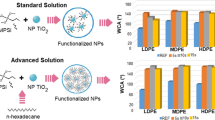Summary
The surface of high density polyethylene (HDPE) was modified using a two-step chemical process. HDPE panels were initially immersed in a heated, aqueous hypochlorite solution containing a carboxylic acid promoter and quenched with deionized water at room temperature following a heterogeneous chemical reaction process patented by Beholz (U.S. Patents 6,077,913 and 6,100,343). 1-5 mole percent chlorine heteroatoms were identified on the resulting HDPE surface using ESCA techniques. The surface chlorine concentration was optimized as a function of reaction time, reaction stoichiometry and number of repeated chemical treatments. The chlorinated HDPE surface was subsequently exposed to ultra-violet (UV) light and surface alkene moieties were noted using ATR FT-IR methods along with a concomitant reduction in surface chlorine from ESCA measurements. The photochemically induced free radical surface dehydrochlorination mechanism was observed to follow first-order kinetics and potentially produce a focussed pattern for information storage. Facile subsequent reactivity of the isolated surface alkene groups was demonstrated using electrophilic addition of Br2. Furthermore, poly(4-hydroxy styrene) architectures were covalently tethered to either the chlorinated or unsaturated HDPE surface in an effort to ultimately tailor surface polarity and adhesiveness as well as create laminate poly(α-olefin) containing structures. This economical and benign surface chlorination/photochemical two-step treatment process produced relatively small disposal risks as well as no apparent polymer degradation.
Similar content being viewed by others
References
Petrie EM (2000) Handbook of Adhesives and Sealants. McGraw-Hill, New York
Feng, Z, Ranby B (1992) Angew Makromol Chem 195(1):17
Beholz LG U.S. Patent (2000) 6,077, 913
Beholz, LG U.S. Patent (2000) 6,100, 343
Aronson, CL, Beholz LG, Burland B, Perez J (2002) Proceedings of 25th Annual Meeting of the Adhesion Society and Second World Congress on Adhesion and Related Phenomena Orlando Florida, pp 295-297
Sounik J U.S. Patent (1996) 5,554,71
Sounik J U.S. Patent (1996) 5,565,544
Vicari R, Lu PH, Kokinda E, Ficner S, Dammel RR (1996) SPIE Advances in Resist Technology and Processing XIII, 2724: 196-207
Kornblum N, Berrigan PJ, LeNoble WJ (1963) J Am Chem Soc, 85:1141
Kornblum N., Seltzer R, Haberfield P (1963) J Am Chem Soc, 85:1148
Wu, S., (1982) Polymer Interface and Adhesion, Marcel Dekker, New York
Briggs D, Brewis DM, Konieczko MB (1977) J Mater Sci, 12:429
Owens DK, Wendt RC (1969) J Appl Polym Sci, 13:1741
Nakamoto K, Oshio H (1985) J Am Chem Soc, 107:6518
Skell, PS, May, DD (1983) J Am Chem Soc, 105:3999
Deker C, Eckhardt A, Ehrburger P (1990) Carbon 28(1):246
Author information
Authors and Affiliations
Corresponding author
Rights and permissions
About this article
Cite this article
Aronson, C., Beholz, L., Beloskur, D. et al. New Pathways for Modifying the Surface of High Density Polyethylene: Chemically Benign Adhesion Promotion and Subsequent Reactivity. Polym. Bull. 53, 401–412 (2005). https://doi.org/10.1007/s00289-005-0344-y
Received:
Revised:
Accepted:
Published:
Issue Date:
DOI: https://doi.org/10.1007/s00289-005-0344-y




